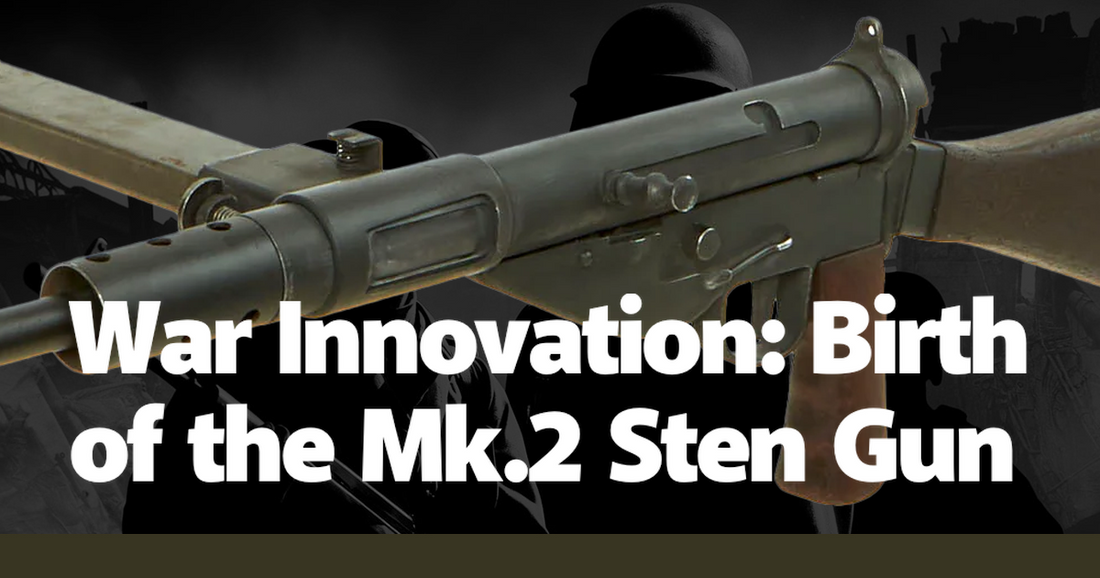The Second World War was a crucible of innovation, with necessity driving rapid advancements in technology and weaponry. Among these innovations, the Mk.2 Sten Gun stands out not only for its effectiveness but also for its emblematic representation of wartime ingenuity. The Sten Gun, a British submachine gun, emerged out of a dire need for a cost-effective, easily producible weapon to arm the Allied forces. Its creation was a direct response to the catastrophic loss of equipment during the Dunkirk evacuation in 1940, where the British Army left behind a significant portion of its arsenal. This context of desperation and resource scarcity set the stage for the Sten Gun's development, a weapon that would become synonymous with the British resistance and the broader Allied war effort.
The Sten Gun's design was a marvel of simplicity and functionality. Unlike its contemporaries, which often required complex machining and expensive materials, the Sten was designed to be produced quickly and cheaply. Its construction utilized stamped metal parts and simple welding techniques, allowing it to be assembled with minimal training and without the need for specialized tools. This approach not only reduced costs but also enabled mass production at a scale that was previously unattainable. Anecdotally, it was said that the Sten Gun could be produced for as little as £2 10s, a fraction of the cost of other submachine guns like the Thompson. This affordability and ease of production were crucial in equipping the vast numbers of troops needed to sustain the war effort.
The Mk.2 variant of the Sten Gun, introduced in 1941, refined the initial design to improve reliability and usability. One of the most notable changes was the introduction of a more robust barrel and a simplified magazine housing, which addressed some of the jamming issues that plagued earlier models. The Mk.2 also featured a distinctive side-mounted magazine, which, while initially awkward for some users, allowed for a more compact and maneuverable weapon. This design choice proved advantageous in the close-quarters combat scenarios that were common in urban warfare and resistance operations. The Mk.2's utilitarian design and adaptability made it a favorite among both regular troops and irregular forces.
The Sten Gun's impact was felt far beyond the front lines. In occupied Europe, resistance fighters and partisans relied heavily on the Sten Gun, which could be airdropped in large quantities and easily distributed among the ranks. Its simplicity allowed for quick training, enabling resistance movements to arm themselves effectively against the Axis powers. Stories abound of Sten Guns being used in daring sabotage missions and ambushes, where their compact size and rapid-fire capability turned the tide in favor of the resistance. One notable example is the assassination of SS General Reinhard Heydrich in Prague, where Czech resistance fighters used Sten Guns to carry out the operation. This act not only demonstrated the weapon's effectiveness but also its symbolic power as a tool of liberation.
Despite its many advantages, the Sten Gun was not without its flaws. Its rudimentary design, while advantageous for mass production, also led to reliability issues. The open-bolt mechanism was prone to accidental discharge if the gun was dropped or jostled, and the magazines were notorious for their tendency to jam. These issues required soldiers to develop a certain level of familiarity and skill to effectively use the weapon. However, the British Army and resistance fighters alike adapted to these quirks, often modifying and maintaining their Sten Guns in the field. This adaptability became a testament to the resilience and ingenuity of the soldiers who wielded them.
The legacy of the Sten Gun extends beyond its immediate wartime use. It influenced the design of subsequent submachine guns, such as the Sterling SMG, which retained many of the Sten's design principles while addressing its shortcomings. The Sten Gun's emphasis on simplicity, cost-effectiveness, and ease of production set a new standard for military small arms development. Its impact can be seen in the design philosophies of modern firearms, which continue to prioritize these same qualities. The Sten Gun's story is a reminder of how necessity can drive innovation in ways that leave a lasting legacy.
In reflecting on the Mk.2 Sten Gun, it is clear that its development was not just a technical achievement but also a strategic one. It provided the Allied forces with a critical tool at a time when resources were scarce and the stakes were incredibly high. The Sten Gun's role in the broader context of the war highlights the interconnectedness of technological innovation and battlefield success. It underscores the importance of adaptability and resourcefulness in overcoming seemingly insurmountable challenges. The Sten Gun, in its simplicity and effectiveness, encapsulates the spirit of wartime innovation and the relentless drive to achieve victory against the odds.
Ultimately, the Mk.2 Sten Gun is more than just a weapon; it is a symbol of wartime resilience and ingenuity. Its creation was a direct response to a moment of crisis, and its success was a testament to the ability of the Allied forces to adapt and innovate under pressure. The stories of the soldiers and resistance fighters who used the Sten Gun bring to life the human element behind this technological marvel, illustrating how a simple piece of machinery can become a crucial instrument of war. As we look back on the history of the Sten Gun, we are reminded of the profound impact that innovation can have in shaping the course of history.

